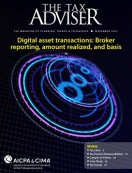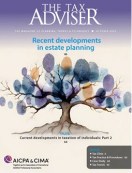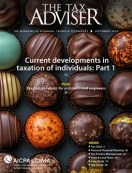- column
- TAX TRENDS
Supreme Court: Tax Court lacks jurisdiction when levy is satisfied
Related
IRS clarifies health savings account changes in H.R. 1 in new notice
PTEs need more notice of changes, more time to respond, AICPA says
IRS announces prop. regs. on international tax law provisions in OBBBA
The Supreme Court, reversing the Third Circuit, held that the Tax Court lacks jurisdiction over appeals from Collection Due Process (CDP) hearings when there is no longer an ongoing levy under Sec. 6330.
Background
On Sept. 12, 2012, Jennifer Zuch and Patrick Gennardo, a married couple, each filed a late married–filing–separately tax return for the 2010 tax year. Zuch’s return showed adjusted gross income (AGI) of $74,493 and an overpayment of tax of $731. Gennardo’s return showed AGI of $1,077,213 and tax due of $385,393. On that same day, Gennardo filed an offer in compromise (OIC) with the IRS for the 2007 to 2011 tax years.
In June 2010, the couple had sent in an estimated payment for 2010 of $20,000, and in January 2011, Gennardo sent a second 2010 estimated tax payment of $30,000. The couple did not specify how these payments should be allocated between them, and Zuch’s late–filed 2010 tax return did not mention them. The IRS allocated the full $50,000 to Gennardo’s return.
In November 2012, Zuch filed an amended 2010 tax return to report additional income of $71,000 and additional tax owed of $27,682, due to a retirement account distribution. On that return, she claimed the benefit of the same $50,000 in estimated payments and requested a refund of $21,918.
The IRS assessed the additional tax Zuch reported, but the Service did not credit her the $50,000 in estimated payments and did not pay her a refund. It also allegedly sent her a notice and demand for payment of her additional tax due, but Zuch disputed that the IRS sent her this notice.
In March 2013, Gennardo filed an amended return for the 2010 tax year. He included a statement with the return that he was amending it partly to notify the IRS that the $50,000 of 2010 estimated payments the couple made should be allocated to Zuch. However, the IRS did not adjust the allocation of the $50,000 from Gennardo to Zuch.
In June 2013, Gennardo submitted an amended OIC to increase the amount of his offer, which the IRS accepted the next month. As part of accepting the offer, the IRS gave him a document showing it had credited the $50,000 of 2010 estimated payments to his outstanding tax liability.
Because the IRS took the position that Zuch still had an outstanding liability for 2010, it sent her a levy notice that informed her she had 30 days to appeal the levy against her property by requesting a CDP hearing. Zuch timely requested a CDP hearing. Having not received a notice of deficiency or otherwise had an opportunity to dispute her tax liability, she exercised her right to challenge the underlying tax liability in the CDP proceedings. Specifically, she claimed her tax liability should be zero because she should have been credited the $50,000 of estimated payments that she and Gennardo had made. Prior to the CDP hearing, Zuch’s counsel submitted a signed declaration from Gennardo directing the IRS to apply the $50,000 to Zuch’s personal tax liability.
In the CDP hearing, an Appeals officer told Zuch’s counsel that he did not believe that the IRS could credit any of the estimated payments to Zuch’s liability because the payments had already been credited to Gennardo’s account as part of his OIC. After the hearing, the Appeals Office sent Zuch a notice of determination sustaining the IRS’s proposed levy, stating it was “not in a position” to move credits from Gennardo’s account to hers.
Zuch timely petitioned the Tax Court to review the CDP hearing determination. The court remanded the case back to Appeals for further factual development. Appeals sustained the levy, and proceedings resumed in the Tax Court.
The original CDP hearing and the Tax Court proceedings spanned several years. During this time, the IRS remained active with respect to the liability it claimed Zuch owed. On six occasions — in 2013, 2014, 2015, twice in 2016, and in 2019 — the IRS used a refund Zuch was due to set off the remainder of her 2010 unpaid tax. After the IRS’s 2019 setoff, Zuch’s balance due for 2010 was $0.
At this point, Zuch was still ready to dispute the application of the estimated tax payments and her liability for 2010 in Tax Court, but the IRS made a motion to dismiss her case as moot because she had no more unpaid tax liability. Zuch opposed this motion, but the Tax Court granted it and dismissed her case, stating there was “no unpaid liability … upon which a levy could be based” and the IRS was “no longer pursuing the proposed collection action” (Zuch, No. 25125–14L (T.C. 4/6/22, order of dismissal)). Further, the Tax Court reasoned that it was not the proper forum to determine whether Zuch had overpaid her tax liability because it lacked jurisdiction to determine an overpayment or to order a refund or credit of tax paid in a CDP proceeding.
This meant that if Zuch wanted to recover her overpayments — which would require her to prevail in her long–running dispute with the IRS about her 2010 tax liability — she would have to file a refund action. Zuch appealed the Tax Court’s decision to the Third Circuit.
The Third Circuit vacated the Tax Court’s dismissal of Zuch’s case and held that the IRS’s decision not to pursue the levy did not moot the Tax Court proceedings (Zuch, 97 F.4th 81 (3d Cir. 2024)). The Third Circuit reasoned that Sec. 6330(c)(2)(B) authorized Zuch to raise “challenges to the existence or amount of the underlying tax liability,” and Zuch still disputed the IRS’s allocation of the $50,000 in estimated tax payments to her now ex–husband. According to the Third Circuit, a declaration by the Tax Court in Zuch’s favor would not be a “dead letter” because such a declaration might be preclusive in a future refund proceeding by Zuch against the IRS. Although the Third Circuit found that the Tax Court could not itself order the IRS to give Zuch a refund, it could enter a declaration that Zuch might be able to use to secure one.
In reaching this conclusion, the Third Circuit created a split with the Fourth and D.C. Circuits, which have held that the Tax Court lacks jurisdiction over a CDP proceeding when there is no longer an underlying levy. The IRS appealed the decision to the Supreme Court, which agreed to hear the case to resolve the split.
The Supreme Court’s decision
The Supreme Court, reversing the Third Circuit, held that the Tax Court had properly dismissed Zuch’s appeal of the IRS’s determination in her CDP hearing. The Court, as had the Fourth and D.C. Circuits, found that the Tax Court lacks jurisdiction under Sec. 6330 to resolve disputes between a taxpayer and the IRS when the Service is no longer pursuing a levy.
As the Supreme Court noted, under its precedent, the Tax Court is a court of limited jurisdiction. Zuch and the IRS agreed that the only jurisdiction–conferring provision applicable in her case was Sec. 6330(d)(1), which states that the Tax Court “shall have jurisdiction” to “review” a “determination” made by an Appeals officer in a CDP hearing. Thus, what mattered in the case was the scope of a “determination” under Sec. 6330(d)(1).
The IRS argued that a “determination” in this context is simply a decision as to whether a levy may go forward; if there is no longer a proposed levy, there is no adverse determination of which the taxpayer may seek review in the Tax Court. Zuch countered that a “determination” encompasses the Appeals officer’s resolution of all the issues raised by the taxpayer at the CDP hearing. In her case, the Appeals officer in the CDP hearing concluded that the $50,000 in estimated tax payments should be credited to Gennardo. Zuch contended that the Tax Court could still review that conclusion, even though the IRS had abandoned the possible levy, and, if the Tax Court held in her favor, the IRS would then refund her the amount it had withheld.
The Supreme Court agreed with the IRS that “determination” in Sec. 6330(d)(1) refers to the binary decision of whether a levy may proceed. Sec. 6330(c)(3), which sets forth the basis for an Appeals officer’s determination, states that it “shall take into consideration” three things: a verification that the IRS has complied with “any applicable law,” the “issues raised” by the taxpayer, and whether the levy “balances the need for the efficient collection of taxes” against concerns that a levy “be no more intrusive than necessary.” The Court noted that the statute speaks in terms of “inputs” (the three considerations articulated in Secs. 6330(c)(3)(A)—(C)) and an “output” (the Appeals officer’s ultimate “determination”). In Zuch’s case, the dispute about her estimated tax payments was an input into the “determination”: an “issu[e] raised” by Zuch that the Appeals officer was required to consider. The “determination” was the Appeals officer’s decision upholding the IRS’s decision to issue a levy.
The Supreme Court also concluded that the statutory context supports the IRS’s interpretation. As the Court observed, under Sec. 7421(a), taxpayers cannot challenge disputes about tax liability without first paying the disputed taxes, and had the IRS offset Zuch’s overpayments against her tax bill without pursuing a levy, her only option would have been to sue for a refund. She was able to depart from the ordinary course only because the IRS proposed a levy, which triggered her right to a CDP hearing. The Court stated that, “as one might expect,” Sec. 6330 focuses on a proposed levy. Because of Sec. 6330’s unwavering focus on levies and the default rule requiring post–payment suits, the Court found “it would be strange if a taxpayer could use a [Sec.] 6330 appeal to resolve tax disputes that no longer have any connection to an ongoing levy.”
Finally, the Supreme Court stated it was skeptical that the Tax Court could provide any relief under Sec. 6330(e) that went beyond an order enjoining a levy, as Sec. 6330(e)(1) authorizes the Tax Court to enjoin the beginning of a levy or proceeding, but only in respect of the unpaid tax or proposed levy to which the determination being appealed relates. The provision does not authorize the Tax Court to order a refund or to issue a declaratory judgment that resolves disputes about tax liability. The Court acknowledged that the Tax Court’s authority to issue injunctive relief against a levy necessarily includes the ability to make declarations about the validity of the tax obligations underlying it, but only when there is a levy.
Based on these statutory constraints, the Supreme Court found that the Tax Court had properly dismissed Zuch’s appeal. The Court explained that the Appeals officer issued a “determination” that the IRS’s proposed levy on Zuch’s property could go forward. The Tax Court had jurisdiction to review that determination. As part of that review, the Tax Court initially had authority to consider whether the Appeals officer’s conclusions, including whether the $50,000 should have been credited exclusively to Gennardo, were correct.
Once the IRS used Zuch’s overpayments to zero out the balance she allegedly owed, there was no longer any basis for a levy, and thus the Supreme Court found that there was no relevant determination for the Tax Court to review. At this point, Zuch’s appeal amounted to a request that the Tax Court issue an opinion on a disputed question of tax liability independent of any ongoing collection effort. Because it lacked jurisdiction to do so, the Tax Court was right to dismiss the case, the Supreme Court held.
The Court pointed out that “none of this means that Zuch lacks recourse against the IRS. Like any taxpayer, she may file a postdeprivation suit for a refund.” The Court noted that in fact Zuch has already filed a refund suit (Zuch, No. 2:25–cv–01900 (D. N.J. 3/14/25)).
Reflections
A dissent in the case pointed out that a taxpayer may not be able to simply file a refund claim in a situation like Zuch’s because of the statutory deadline on the filing of a claim for refund (Sec. 6511(a)). Under this deadline, taxpayers cannot bring a refund suit until they have filed administrative claims with the IRS within three years from the time the return was filed or two years from the time the tax was paid, whichever period ends later. The dissent noted that taxpayers who choose to contest their tax liability in Sec. 6330 proceedings may not know that they need to file such an administrative claim until the time for doing so has passed.
Accordingly, the dissent stated that, under the majority’s decision, Sec. 6330 proceedings are essentially risk–free for the IRS. The Service may pursue a levy and argue its case to the Tax Court, and if the court seems likely to side with the taxpayer, it can drop the levy and avoid an unfavorable ruling on the taxpayer’s underlying tax liability. This, in the dissent’s view, will often be only a small setback for the IRS because it remains free to pursue other collection methods. On the other hand, the taxpayer, because of the statute of limitation, will often be left “without any way to challenge the IRS’s error or prevent the agency from keeping more of her money than it is lawfully due.”
Zuch, No. 24-416 (U.S. 6/12/25)
Contributor
James A. Beavers, CPA, CGMA, J.D., LL.M., is The Tax Adviser’s tax technical content manager. For more information about this column, contact thetaxadviser@aicpa.org.














